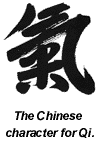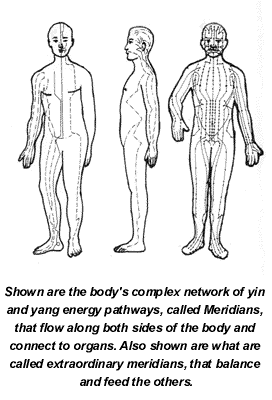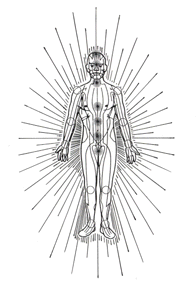Qi gong: An Introduction
by Christopher Caile
Qi gong is also known as Chi Kung, or Kiko in Japanese. Qi gong is the
ancient Chinese art of energy training or practice. "Qi" (Chi) means energy
and "gong" (Kung) means work or practice. In China it is used in traditional
hospitals and clinics to treat a wide range of conditions from arthritis
to cancer. Millions also do qi gong exercises to boost vitality, to insure
against disease or to fight chronic conditions. Its energy methods are
also an integral part of Tai Chi, many martial disciplines, as well as
Taoist and Buddhist practices. In the West qi gong has only recently become
known (over the last 20 years), but it may be the oldest of all the Chinese
healing arts with roots tracing back over thousands of years. Other Traditional
Chinese Medicine (TCM) members include acupuncture, T'un-na (a predecessor
to Japanese Shiatsu) and herbal medicine.
 Long
before the advent of modern medicine, the Chinese developed their own
concepts of health and healing based on energy. Not having (or relying
on) modern biochemistry or anatomical models, understanding was instead
developed from generations of careful observations, correlation and testing.
The great insight of the Chinese (as well as other cultures such as India)
was that underlying the physical body's functions and processes was a
deeper, more profound level - one of energy - energy that not only influenced
health and resistance to disease but could be also used and developed
to boost vitality, for treatment and for diagnostics. In this equation
the spirit is considered one type of energy, and emotions (psychological
manifestations) are often seen as interconnected to underlying conditions.
Processes too, are often seen differently (not relegated to neat anatomical
units). Thus, while qi gong (and TCM in general) recognizes the same organs
and systems as does Western science, its focus is different. It looks
at underlying energy relationships, balances, and interrelated, general
processes. Long
before the advent of modern medicine, the Chinese developed their own
concepts of health and healing based on energy. Not having (or relying
on) modern biochemistry or anatomical models, understanding was instead
developed from generations of careful observations, correlation and testing.
The great insight of the Chinese (as well as other cultures such as India)
was that underlying the physical body's functions and processes was a
deeper, more profound level - one of energy - energy that not only influenced
health and resistance to disease but could be also used and developed
to boost vitality, for treatment and for diagnostics. In this equation
the spirit is considered one type of energy, and emotions (psychological
manifestations) are often seen as interconnected to underlying conditions.
Processes too, are often seen differently (not relegated to neat anatomical
units). Thus, while qi gong (and TCM in general) recognizes the same organs
and systems as does Western science, its focus is different. It looks
at underlying energy relationships, balances, and interrelated, general
processes.
Thus when Western medicine sees a problem, like a stomach condition, the
diagnoses ties it (deductively) to a cause. Thus, an anti-acid might be
used for all those who suffer in common from indigestion. Qi gong, as
well as TCM, might treat each patient differently, in each case the treatment
tied to restoring important underlying conditions, balances and levels
of energy that constitute health and vitality. Once these are in place
the body restores its own health. This is an important consideration.
Health is not seen just as an absence of symptoms, disease or in terms
of a healthy outward appearance. It's what's happening inside (energy
vitality and balance) that is critical, especially as age takes its toll
on our immune system and body functions (immune strength typically falling
be a much as 70% by the time most people reach 70).
Qi gong is similar to Therapeutic Touch, Reiki, Healing Touch and other
energy medicines in that they all are able to affect individuals with
their own energy or energies directed through them. Qi gong (and TCM),
however, is different in that it has its own distinct model of the body
in terms of energies and their relationships. A qi gong practitioner might
just transmit a general healing or balancing energy to others. More experienced
practitioners, however, might use pure yin or yang energy, or use energies
at various frequencies mixed with various intents (specific intentions
mixed with emotional content) that can have different effects. For example,
a person whose skin is raw from radiation treatment, sunburn or a burn
can be soothed (will experience a cooling effect) by sending cool yin
energy to the affected area. Other energies, often experienced as warming,
can greatly affect the speed of healing within the body from injury or
operation. A bruise on the hand, foot, or face (a hard area) can often
even be countered, the swelling and blood accumulation re-absorbed by
the body, if treated quickly as the condition is developing. Some qi gong
traditions utilize the practitioner's own body energy (often drawn from
different body centers of energy) for these purposes, but many more only
use their own energy to help to jump start, and/or channel other energies
through themselves to others, intent (specific intentions mixed with emotional
content) used by some to provide a specific mental color or charge to
the channeled energy. Qi gong also differs from these other systems in
that it includes a wealth of self-practice techniques and methods.
 In
the Chinese energy model, the body is the meeting place of both Yin energy
from the earth and Yang energy from above. These dual manifestations in
turn meet within and replenish man (renewable energies). Some energies
can be beneficial, others potentially harmful in effect. We also depend
upon them, taking them in to replenish our energy. They are hosted in
food, drink and through breath (air), or are directly absorbed through
the skin and body energy centers, as well as through effects on the body's
surrounding energy fields. Inside the body these renewable energies mix
with the body's own - inherited (genetic constitution) energies (Jing)
and spirit (Shen). Together they produce the energies critical to the
physical body's function and vitality - the balance and harmony between
yin and yang, as well as between Qi, Jing and Shen are seen to be critical
to health. In this equation emotions are seen as related to underlying
conditions and to organ function. Energies are also concentrated in certain
body centers, or tan tiens (or dan tiens, tandams in Japanese) or organ
systems, and flows (circulates) through pathways (meridians) that interconnect
organs which have specific energy relationships (Five Elements Theory)
and yin, yang balances. Certain other energies are also produced, such
as Protective Energy that serves as an important function in what we now
understand as immune function. In
the Chinese energy model, the body is the meeting place of both Yin energy
from the earth and Yang energy from above. These dual manifestations in
turn meet within and replenish man (renewable energies). Some energies
can be beneficial, others potentially harmful in effect. We also depend
upon them, taking them in to replenish our energy. They are hosted in
food, drink and through breath (air), or are directly absorbed through
the skin and body energy centers, as well as through effects on the body's
surrounding energy fields. Inside the body these renewable energies mix
with the body's own - inherited (genetic constitution) energies (Jing)
and spirit (Shen). Together they produce the energies critical to the
physical body's function and vitality - the balance and harmony between
yin and yang, as well as between Qi, Jing and Shen are seen to be critical
to health. In this equation emotions are seen as related to underlying
conditions and to organ function. Energies are also concentrated in certain
body centers, or tan tiens (or dan tiens, tandams in Japanese) or organ
systems, and flows (circulates) through pathways (meridians) that interconnect
organs which have specific energy relationships (Five Elements Theory)
and yin, yang balances. Certain other energies are also produced, such
as Protective Energy that serves as an important function in what we now
understand as immune function.
In addition to a different energy model, qi gong is also different from
many other energy systems in that it includes self-practice. Qi gong can
be done alone, at any time, standing, sitting or even when confined to
bed. Exercises can be stationary, moving or both. They use breathing techniques,
meditations, visualizations, sounds, vibrations, pressure point manipulations
and movement mixed with intention as well as sensory awareness to lead,
direct, balance or strengthen energy flow.
 As
a healing art, qi gong works gradually to correct imbalances. If conditions
have gone to far and they are critical or life threatening, other intervention
is often needed. Qi gong is not a quick fix, although some results do
come relatively quickly. But it doesn't directly heal. It only affects
energy. The body heals itself through energy. Results also improve with
practice as people develop energy and their energy skills. As
a healing art, qi gong works gradually to correct imbalances. If conditions
have gone to far and they are critical or life threatening, other intervention
is often needed. Qi gong is not a quick fix, although some results do
come relatively quickly. But it doesn't directly heal. It only affects
energy. The body heals itself through energy. Results also improve with
practice as people develop energy and their energy skills.
Qi gong practice includes sets of movements, as well as fixed postures
and meditations. Some practices are aimed at overall strengthening and
regulation of energy, while others are more specific and targeted - used
to stimulate and regulate energy flow, oxygen intake and blood flow as
well as to massage organs, stimulate glands, promote lymphatic flow and
stimulate the parasympathetic branch of the Central Nervous System. Some
say qi gong resembles a mix of moving yoga and self-chiropractic. Others
say it looks like tai chi without steps or it is zen with intention. Qi
gong is also often combined with acupuncture, herbal medicine and T'un-na.
At a minimum qi gong practice is deeply relaxing and stimulates brain
alpha or beta wave function. Practice also make people feel more vitalized
and immune function can be increased. Chronic conditions often improve.
Many are able to combat simple medical problems from tooth aches to minor
infections. Injuries, cuts and bruises heal faster. Serious practitioners
often evidence changes in skin (rebuilding connective tissue). For disease
prevention, treatment of chronic conditions, healing, maintaining vitality
and extension of life, the system is without parallel. This is not to
say that Western medicine is not effective. It is certainly superior for
emergency medicine, sophisticated diagnostics and treatment of viral infection.
But it also has limitations. Western medicine has less than a sterling
record with many chronic conditions, or conditions related to stress.
A lot also has to be learned about healing and bolstering immune capability.
Energy practices in the martial disciplines often differ from those in
the healing arts and can use different energy as well, including yang/jing
energy combined with intent and projections of attitudes, mental states
or emotions (to mentally unbalance or even move an opponent). Certain
practices are also used to protect the body from injury and to increase
strength. Some exercises bolster the body's ability to absorb blows to
virtually any area except the eyes. This is often call Iron Shirt or Iron
Bell training in the Chinese arts and body conditioning in the Okinawan
and Japanese arts. Some systems employ striking, gripping or pressure
techniques to affect acupuncture points (often co-located with neurological
points) in combinations that have an effect not understood in Western
science. Energy flow is disrupted, enhanced or interrupted in such a way
as to affect (1) muscular function and strength, (2) blood flow and pressure,
(3) structure (bone and ligament), (4) organ function, such as the ability
to breath and heart function, (4) internal orientation, as in balance
and mental stability, or the brain's ability to process incoming stimuli.
In some martial systems internal energy is also combined with relaxed,
quick, or whip like actions to enhance strength and/or the affect of striking
energy to penetrate an opponent's body. Energy can also be projected to
affect the opponent's energy, balance, or muscle ability.
As part of Taoism, qi gong energy practices are also used as a vehicle
to achieve immortality. Some Buddhist traditions also have qi gong roots.
In these disciplines careful guidance of a trained teacher is essential.
|